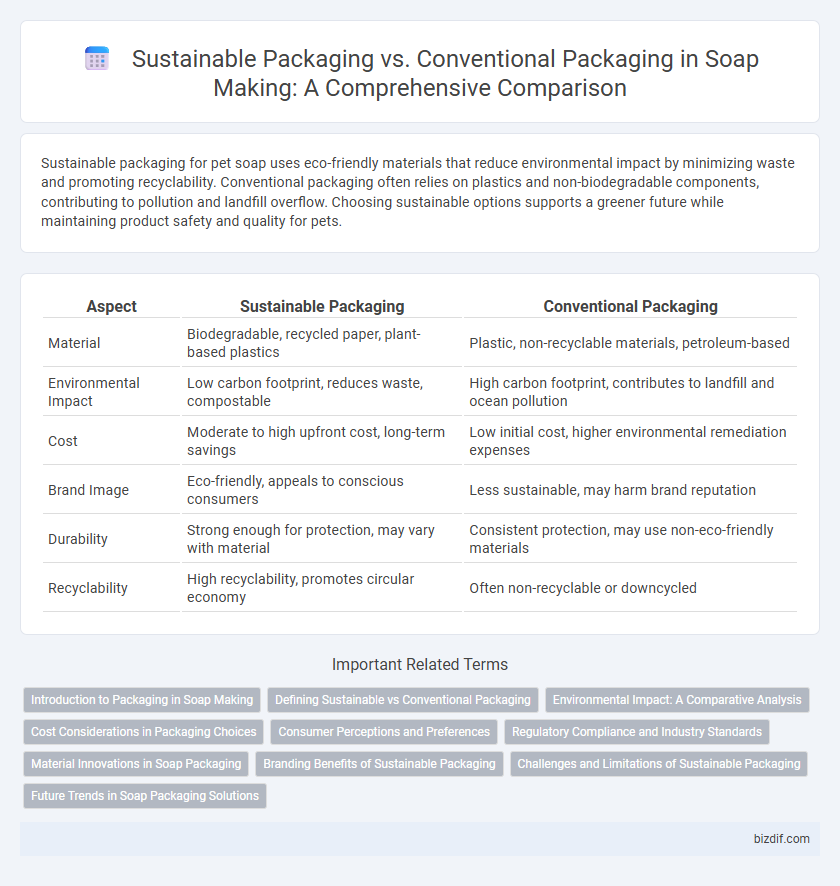Sustainable packaging for pet soap uses eco-friendly materials that reduce environmental impact by minimizing waste and promoting recyclability. Conventional packaging often relies on plastics and non-biodegradable components, contributing to pollution and landfill overflow. Choosing sustainable options supports a greener future while maintaining product safety and quality for pets.
Table of Comparison
| Aspect | Sustainable Packaging | Conventional Packaging |
|---|---|---|
| Material | Biodegradable, recycled paper, plant-based plastics | Plastic, non-recyclable materials, petroleum-based |
| Environmental Impact | Low carbon footprint, reduces waste, compostable | High carbon footprint, contributes to landfill and ocean pollution |
| Cost | Moderate to high upfront cost, long-term savings | Low initial cost, higher environmental remediation expenses |
| Brand Image | Eco-friendly, appeals to conscious consumers | Less sustainable, may harm brand reputation |
| Durability | Strong enough for protection, may vary with material | Consistent protection, may use non-eco-friendly materials |
| Recyclability | High recyclability, promotes circular economy | Often non-recyclable or downcycled |
Introduction to Packaging in Soap Making
Sustainable packaging in soap making utilizes biodegradable materials such as recycled paper, plant-based plastics, and compostable wraps, reducing environmental impact compared to conventional packaging that often relies on non-recyclable plastics and synthetic materials. This shift enhances brand reputation by meeting consumer demand for eco-friendly products while minimizing landfill waste and carbon footprint. Choosing sustainable packaging aligns with global efforts to promote circular economy principles within the personal care industry.
Defining Sustainable vs Conventional Packaging
Sustainable packaging in soap making utilizes eco-friendly materials such as recycled paper, biodegradable plastics, or compostable fibers that reduce environmental impact and promote resource conservation. Conventional packaging often involves non-recyclable plastics, synthetic foils, and harmful adhesives that contribute to landfill waste and pollution. Choosing sustainable packaging aligns with eco-conscious consumer values and supports circular economy principles by minimizing carbon footprint and waste generation.
Environmental Impact: A Comparative Analysis
Sustainable packaging in soap making significantly reduces environmental impact by utilizing biodegradable materials and minimizing plastic waste compared to conventional packaging. Life cycle assessments reveal lower carbon footprints and decreased resource consumption associated with sustainable options like recycled paper or plant-based wrappers. Conventional packaging typically relies on non-renewable plastics, contributing to pollution and landfill overflow, whereas sustainable packaging supports circular economy principles and enhances overall eco-friendliness.
Cost Considerations in Packaging Choices
Sustainable packaging often involves higher upfront costs due to eco-friendly materials and production processes, impacting initial investment in soap making. Conventional packaging typically offers lower expenses through mass production and cheaper materials, making it cost-effective for large-scale operations. However, long-term savings and brand value from sustainable packaging can offset initial costs by appealing to environmentally conscious consumers.
Consumer Perceptions and Preferences
Consumer perceptions of sustainable packaging in soap making emphasize eco-friendliness, with many preferring biodegradable or recyclable materials over conventional plastic wraps. Sustainable packaging is often associated with higher product quality and brand responsibility, influencing purchasing decisions and fostering consumer loyalty. Despite a slightly higher price point, customers increasingly favor sustainably packaged soaps due to environmental concerns and a desire for ethical consumption.
Regulatory Compliance and Industry Standards
Sustainable packaging in soap making meets evolving regulatory compliance by adhering to stringent environmental laws such as the EU Packaging Directive and the U.S. EPA's Sustainable Materials Management guidelines, ensuring reduced waste and toxicity. Conventional packaging often relies on non-biodegradable plastics that fail to align with industry standards promoting recyclability and carbon footprint reduction. Embracing sustainable alternatives enhances brand credibility by complying with ISO 14001 environmental management standards and global eco-label certifications.
Material Innovations in Soap Packaging
Material innovations in soap packaging prioritize sustainability by utilizing biodegradable, compostable, and recycled materials such as plant-based bioplastics, hemp paper, and mushroom mycelium. These eco-friendly alternatives reduce plastic waste and carbon footprint compared to conventional packaging made from petroleum-based plastics and non-recyclable components. Advances in sustainable packaging also include water-activated inks and minimalistic designs that enhance product shelf life while supporting circular economy principles in the soap industry.
Branding Benefits of Sustainable Packaging
Sustainable packaging enhances brand reputation by aligning soap products with eco-friendly values, attracting environmentally conscious consumers. It differentiates brands in a crowded market, fostering customer loyalty through transparent, responsible practices. Using renewable, biodegradable materials also reduces environmental impact, reinforcing a brand's commitment to sustainability.
Challenges and Limitations of Sustainable Packaging
Sustainable packaging in soap making often faces challenges such as higher material costs and limited availability of eco-friendly alternatives compared to conventional packaging. Biodegradable and compostable materials may compromise product protection and shelf life, leading to increased waste and customer dissatisfaction. Furthermore, sustainable packaging frequently requires specialized recycling infrastructure that is not universally accessible, limiting its environmental benefits.
Future Trends in Soap Packaging Solutions
Future trends in soap packaging solutions emphasize sustainable materials like biodegradable bioplastics, recycled paper, and plant-based inks to reduce environmental impact compared to conventional plastic packaging. Innovations include compostable wrappers and refillable container systems designed to minimize waste and enhance product lifecycle sustainability. Growing consumer demand for eco-friendly packaging is driving soap manufacturers to adopt circular economy principles, integrating renewable resources and improving recyclability in soap packaging.
Sustainable Packaging vs Conventional Packaging Infographic

 bizdif.com
bizdif.com